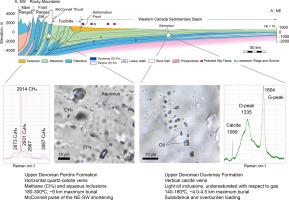Fracture systems and fluid inclusions in Upper Devonian organic-rich shales in the Western Canada Sedimentary Basin and Rocky Mountains Foreland Belt, West-Central Alberta, Canada
IF 10
1区 地球科学
Q1 GEOSCIENCES, MULTIDISCIPLINARY
引用次数: 0
Abstract
Unraveling phases of fracture formation and hydrocarbon generation enhances our understanding of the maturation and burial history of organic-rich shales. The Upper Devonian organic-rich shales of the Western Canada Sedimentary Basin (Duvernay Formation) and the Rocky Mountains Foreland belt (Perdrix Formation) experienced distinct structural and burial histories reflected in the orientation and mineralization of developed veins, and the temperature and composition of trapped fluid inclusions. Duvernay shales typically contain vertical and sub-vertical calcite veins with light oil inclusions. The compositions and homogenization temperatures of these inclusions indicate that the trapped fluids are more liquid-rich than the produced fluids and were likely trapped under variable overpressures during fracturing. These inclusions may have formed prior to peak burial (e.g., ∼140 °C), while further burial (maximum <160 °C, at a depth of 4.5 km) resulted in generation of the current reservoir fluid (mostly gas with minor condensate). In contrast, Perdrix shales commonly contain horizontal and sub-horizontal quartz-calcite veins with gas and two-phase aqueous inclusions, where the gas phase is predominantly methane with minor ethane, propane, and benzene indicated by Raman and mass spectrometry. The compositions and temperatures of fluid inclusions in the Perdrix outcrop samples of the Foreland Belt are consistent with highly mature, free-phase thermogenic gas trapped at highly variable temperatures ranging from 180 °C to ≥300 °C (mostly 220–270 °C) and at burial depths of up to 9 km. The results obtained help us analyze the tectonic evolution, stresses, and pressures experienced by the Upper Devonian shales within the mountain ranges and the basin.

加拿大西部沉积盆地和落基山脉前陆带上泥盆统富有机质页岩裂缝体系及流体包裹体
裂缝形成和生烃阶段的揭示有助于我们对富有机质页岩成熟和埋藏史的认识。加拿大西部沉积盆地(Duvernay组)和落基山脉前陆带(Perdrix组)的上泥盆统富有机质页岩经历了独特的构造和埋藏史,这些构造和埋藏史反映在发育的矿脉方向和矿化程度以及包裹体的温度和组成上。Duvernay页岩通常含有垂直和亚垂直方解石脉,内含轻质油包裹体。这些包裹体的组成和均质温度表明,被困流体比产出流体更富液,可能是在压裂过程中被变超压捕获的。这些包裹体可能是在峰值埋藏(例如,~ 140℃)之前形成的,而进一步的埋藏(最高160℃,深度为4.5 km)导致了当前储层流体的产生(主要是气体和少量凝析油)。相比之下,Perdrix页岩通常含有水平和亚水平石英方解石脉,含有气相和两相水包裹体,其中气相主要是甲烷,少量乙烷、丙烷和苯通过拉曼和质谱分析显示。前陆带Perdrix露头样品中流体包裹体的组成和温度与高度成熟的自由相热成因气体一致,这些气体被困在180°C至≥300°C(大部分为220-270°C)高度变化的温度范围内,埋藏深度可达9 km。研究结果有助于分析上泥盆统页岩在山脉和盆地内的构造演化、应力和压力。
本文章由计算机程序翻译,如有差异,请以英文原文为准。
求助全文
约1分钟内获得全文
求助全文
来源期刊

Earth-Science Reviews
地学-地球科学综合
CiteScore
21.70
自引率
5.80%
发文量
294
审稿时长
15.1 weeks
期刊介绍:
Covering a much wider field than the usual specialist journals, Earth Science Reviews publishes review articles dealing with all aspects of Earth Sciences, and is an important vehicle for allowing readers to see their particular interest related to the Earth Sciences as a whole.
 求助内容:
求助内容: 应助结果提醒方式:
应助结果提醒方式:


